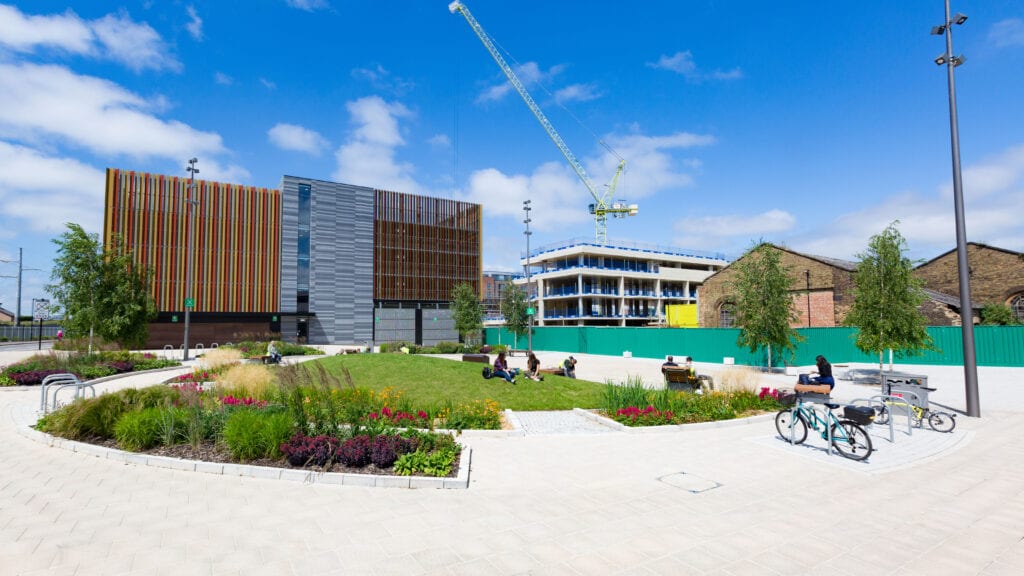
Looks all too familiar, doesn’t it? Far too often we are seeing images across our news channels on localised and global flooding.
According to the UK Environment Agency, over 5 million homes are at risk of flooding in England alone. The average cost of flooding to a home is £30k and the mental health impacts are long-lasting.
Even if you’ve never been flooded, you can sympathise with people whose homes you see on TV, with furniture floating in filthy water. But consider this: we are responsible. We all contribute to these floods. From the roofs over our heads to the roads we drive on; from pavements to shopping centres and their car parks; from schools to business parks – all the impermeable surfaces that make way for our everyday lives prevent rainwater from being absorbed where it falls.
Drainage systems designed to take rainwater away may have been up to the job when they were first designed, but they have become overwhelmed by the challenges of larger populations, increased urbanisation and a changing climate. That’s why people are looking increasingly to sustainable solutions for the answer: solutions that can accommodate changes without compromising the future.
We need sustainable urban drainage systems (SuDS) – solutions that replace hard engineering, nature-based designs – to tackle the looming challenges of poor water quality, climate change and tight budgets

This doesn’t mean replicating a hard engineered system with something ‘softer’, although this is how some designers and developers have interpreted the legislation that underpins SuDS. Often referred to as ‘pipe to pond’ systems, a great many SuDS solutions use hard engineering to transport rainwater to an attenuation area which may be a natural solution; a swale or maybe a pond.
Of course, a solution that’s designed to alleviate flooding must perform its primary task. For that, the designer has to have confidence that comes from the numbers. Calculating the flow and volume required to handle runoff can lead to an obvious ‘pipe to pond’ solution and can result in the ‘pond’ becoming a dominant feature, attracting negative publicity along the way. Even ‘successful’ SuDS schemes – i.e. those that reduce the risk of flooding and meet building regulations – have received criticism for being unsightly, polluted and sometimes hazardous by posing a drowning risk to children (frequently used as an objection to planning applications). What’s more, they aren’t even the most efficient way for developers to manage runoff as the size of the pond or swale could take up more valuable development land than necessary to handle exceedance flows.
These unimaginative ways of meeting regulatory demands do not take full advantage of the opportunities that SuDS offer, especially with regards to the four pillars of sustainable drainage outlined by Susdrain: quantity, quality, amenity and biodiversity. By looking more holistically at the problem and its solution to incorporate other, natural structures in a drainage design, designers and engineers can manage resources better and create more sustainable solutions. Slowing the flow by intercepting runoff closer to its source naturally reduces the volume of water reaching an attenuation point – reducing the amount of land taken and increasing amenity along the way.

At GreenBlue Urban, we’ve recognised this as a stumbling block and have worked to overcome it. We have developed ways to help you determine the degree of interception, ground infiltration and saturation within a linked system of engineered tree pits, and the impact this has on your overall scheme. Our specially engineered products have been used to very positive effects in schemes around the world Breda in the Netherlands as highlighted above, in the UK in Grangetown in Cardiff, Fletton Quays, Peterborough and Kenmont Gardens in London to reduce volume, remove pollutants and even alleviate traffic problems.

A new way of thinking is required: a way of bringing engineering and landscape design closer by incorporating natural engineering into practical, sustainable drainage design.
The good news is that when drainage engineers embrace this new way of thinking, they create innovative nature-based solutions that encourage amenity and biodiversity while achieving the primary goal of reducing flood risk, solving multiple problems along the way.
GBUs mission is to be the interface between nature and the built environment, designing for BLUE with our enhanced stormwater solutions should be at the core of your drainage design strategy, adding value to developments, floodproofing properties, maximising biodiversity, providing equal access to blue and green infrastructure with multi-functional benefits – Anyone anywhere can have a SuDS feature.
